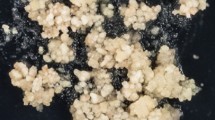Abstract
Germination was readily induced in recalcitrant microspore-derived embryos of Brassica napus ‘Topas’ when they were exposed to a period of chilling (9–12 days at 4°C) or partial desiccation (rapid or slow air drying) prior to germination. In general, embryos thirty-five days old had the highest germination rates as compared to younger or older ones. Populations of embryos were induced to germinate at a rate of over 90% under specific temperature, desiccation and age conditions. Comparisons to an embryogenic B. napus winter line, F346, are made.
Similar content being viewed by others
References
Beversdorf WD & Kott LS (1987) An in vitro mutagenesis/selection system for Brassica napus. Iowa State J. Res. 61: 435–443
Bewley JD & Black M (1982) Physiology and Biochemistry of Seeds. Springer Verlag, New York
Chuong PV & Beversdorf WD (1985) High frequency embryogenesis through isolated microspore culture in Brassica napus L. and B. carinata Braun. Plant Sci. 39: 219–226
Chuong PV, Deslauriers C, Kott LS & Beversdorf WD (1988) Effects of donor genotype and bud sampling on microspore culture of Brassica napus. Can. J. Bot. 66: 1653–1657
Coventry J, Kott L & Beversdorf WD (1988) Manual for microspore culture technique for Brassica napus. Department of Crop Science Tech. Bull. OAC Pub. 0489, University of Guelph
Dasgupta J & Bewley JD (1982) Desiccation of axes of Phaseolus vulgaris during development of a switch from a development pattern of protein synthesis to a germination pattern. Plant Physiol. 70: 1224–1227
Dunwell JM & Cornish M (1985) Influence of preculture variables on microspore embryo production in Brassica napus ssp. oleifera cv. Duplo. Ann. Bot. 56: 281–289
Fan Z, Armstrong KC & Keller WA (1988) Development of microspores in vivo and in vitro in Brassica napus. Protoplasma 147: 191–199
Gamborg OL, Miller RA & Ojima K (1968) Nutrient requirements of suspension cultures of soybean root cells. Exp. Cell Res. 50: 151–158
Gland A, Lichter R & Schweiger H-G (1988) Genetic and exogenous factors affecting embryogenesis in isolated microspore cultures of Brassica napus L. J. Plant Physiol. 132: 613–617
Kermode AR & Bewley JD (1985) The role of maturation drying in the transition from seed development to germination. J. Exp. Bot. 36: 1906–1915
Kott LS, Polsoni L, Ellis B & Beversdorf WD (1988) Autotoxicity in isolated microspore cultures of Brassica napus. Can. J. Bot. 66: 1665–1670
Lichter R (1982) Induction of haploid plants from isolated pollen of Brassica napus. Z. Pflanzenphysiol. 105: 427–434
Mathias R (1988) An improved in vitro culture procedure for embryoids derived from isolated microspores of rape (Brassica napus L.). Plant Breeding 100: 320–322
Polsoni L, Kott LS & Beversdorf WD (1988) Large-scale microspore culture technique for mutation/selection studies in Brassica napus. Can. J. Bot. 66: 1681–1685
Rajasekaran K & Mullins MG (1979) Embryos and plantlets from cultured anthers of hybrid grapevines. J. Exp. Bot. 30: 399–407
Swanson EB, Coumans MP, Brown GL, Patel JD & Beversdorf WD (1988) The characterization of herbicide tolerant plants in Brassica napus L. after in vitro selection of microspores and protoplasts. Plant Cell Rep. 7: 83–87
Swanson EB, Coumans MP, Wu SC, Barsby TL & Beversdorf WD (1987) Efficient isolation of microspores and the production of microspore-derived embryos from Brassica napus. Plant Cell Rep. 6: 94–97
Takeno K, Koshioka M, Pharis RP, Rajasekaran K & Mullins MG (1983) Endogenous gibberellin-like substances in somatic embryos of grape (Vitis vinifera x Vitis rupestris) in relation to embryogenesis and the chilling requirement for subsequent development of mature embryos. Plant Physiol. 73: 803–808
Totterdell S & Roberts EH (1979) Effects of low temperatures on the loss of innate dormancy and the development of induced dormancy in seeds of Rumex obtusifolius L. and Rumex crispus L. Plant Cell Environ. 2: 131–137
Vincent EM & Roberts EH (1979) The influence of chilling, light and nitrate on the germination of dormant seeds of common weed species. Seed Sci. Technol. 7: 3–14
Author information
Authors and Affiliations
Rights and permissions
About this article
Cite this article
Kott, L.S., Beversdorf, W.D. Enhanced plant regeneration from microspore-derived embryos of Brassica napus by chilling, partial desiccation and age selection. Plant Cell Tiss Organ Cult 23, 187–192 (1990). https://doi.org/10.1007/BF00034430
Received:
Accepted:
Issue Date:
DOI: https://doi.org/10.1007/BF00034430




